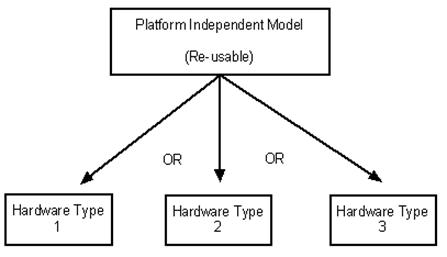
|
System Integration |
|
Dedicated to the dissemination of System Integration information |

|
Platform Independent Models |
|
The information on this page is based on a series of papers by Tony Bloomfield of SELEX-SAS (the company I work for) and Chris Raistrick, Director, Kennedy Carter Ltd. I must also thank Tony Bloomfield for taking the time to explain the process to me. Any mistakes, or misunderstandings, on this page are mine. Platform Independent Models (P.I.M.) is an attempt to control the spiralling software costs of large systems, particularly large defence systems. It does this by separating the design and modelling of a system from the implementation. The system is designed and modelled as a P.I.M. and it is only at the point of implementation, i.e. as late as possible, that the software is loaded onto the hardware. This has 3 main advantages: - 1. The design effort that is put into a P.I.M. is reusable, i.e. it is not a sunk cost. 2. Hardware costs are shifted to the right, i.e. they occur later in the project. The later the costs occur the cheaper a system is over the complete lifecycle. 3. The hardware can be the latest available hardware, i.e. advantage can be taken of the advances made in hardware. Usually hardware is one of the first components to be defined; it is often out of date at the time of delivery. A P.I.M. delays the hardware definition so that the most up to date hardware can be used.
|


|
Without a doubt their will be more ‘layers’ to the model but the above diagram gives a flavour of the intent. If the hardware is defined at a later stage this means that the most up to date hardware can be used which, hopefully, will be designed with System Integration (S.I.) in mind, this should make S.I. easier as the most up to date tools can be used. On the negative side the S.I. engineer may need to have knowledge of more than one type of hardware, i.e. as the software is loaded onto different platforms different hardware related knowledge is required. P.I.M. still has a long way to go before it becomes a widely used development methodology but we are not too far off from using it.
|

|
|